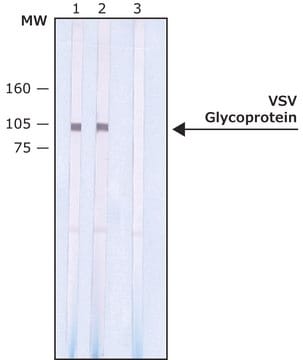A1970
Anti-VSV-Glycoprotein−Agarose antibody, Mouse monoclonal
clone P5D4, purified from hybridoma cell culture, PBS suspension
Sinônimo(s):
Monoclonal Anti-VSV Glycoprotein
About This Item
Produtos recomendados
fonte biológica
mouse
conjugado
agarose conjugate
forma do anticorpo
purified immunoglobulin
tipo de produto de anticorpo
primary antibodies
clone
P5D4, monoclonal
forma
PBS suspension
classe(s) química(is) do analito
proteins (VSV-G)
técnica(s)
immunoprecipitation (IP): suitable
protein purification: suitable
Isotipo
IgG1
capacidade
≥15 nmol/mL, resin binding capacity (VSV-G tagged fusion protein)
Condições de expedição
wet ice
temperatura de armazenamento
2-8°C
Procurando produtos similares? Visita Guia de comparação de produtos
Descrição geral
Especificidade
Imunogênio
Aplicação
Immunoprecipitation (1 paper)
forma física
Nota de preparo
Not finding the right product?
Try our Ferramenta de seleção de produtos.
Código de classe de armazenamento
10 - Combustible liquids
Classe de risco de água (WGK)
nwg
Ponto de fulgor (°F)
Not applicable
Ponto de fulgor (°C)
Not applicable
Certificados de análise (COA)
Busque Certificados de análise (COA) digitando o Número do Lote do produto. Os números de lote e remessa podem ser encontrados no rótulo de um produto após a palavra “Lot” ou “Batch”.
Já possui este produto?
Encontre a documentação dos produtos que você adquiriu recentemente na biblioteca de documentos.
Nossa equipe de cientistas tem experiência em todas as áreas de pesquisa, incluindo Life Sciences, ciência de materiais, síntese química, cromatografia, química analítica e muitas outras.
Entre em contato com a assistência técnica







